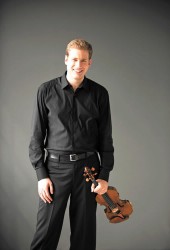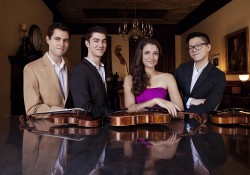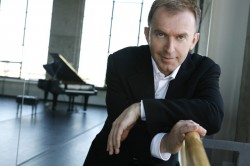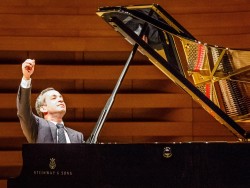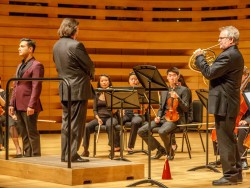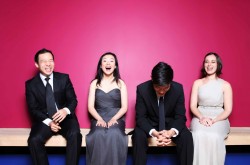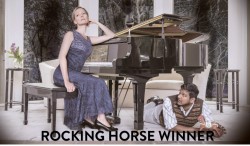Concert Report TSM: Daniel Taylor; Jonathan Crow; Dover Quartet
The Coronation of King George II took place in October of 1727; George Frederic Handel was commissioned to write four anthems for the ceremony. Last July 26, Daniel Taylor led his Theatre of Early Music in a delightful hour-long re-imagining of the event that literally and figuratively was the grand centrepiece of Toronto Summer Music’s “London Calling” season. In addition to using music of the day, Taylor had the wisdom to include three anachronistic elements, Hubert Parry’s I Was Glad and Jerusalem as well as John Tavener’s Hymn to the Mother of God, which broadened the evening and extended the ceremonial maelstrom into the 20th century.
The presence of a real archbishop, a bewigged monarch-to-be and the participation of the large Walter Hall audience in the singing of Jerusalem added to the sense of occasion. The effervescent Taylor and his company had the musical smarts to carry it off. The regal Handel procession and spirited anthems, the big-voiced Orlando Gibbons and the a cappella Palestrina backed up the serious religiosity on display. And Parry’s 1916 setting of Jerusalem, William Blake’s vision of a holy city built “in England’s green and pleasant Land,” crowned the spirit of the British Empire that had ruled the waves for hundreds of years.
TSO concertmaster and TSM artistic director designate, Jonathan Crow, headlined an enjoyable evening of mostly British chamber music, July 28 in Walter Hall. The program began with an invitation into the world of the young Mozart, his Violin Sonata No.10 in B-flat Major, K15, written in London in 1764 while the eight-year-old genius was on a European tour with his violinist sister. Crow and his accommodating collaborative pianist, Angela Park, made the most of the repeated simple theme of the first movement while their well-balanced playing sparked the second.
With Elgar’s meaty Violin Sonata in E Minor, Op.82, the duo’s musicianship was even more evident in the muscular, but sweet, long lines of its first movement. The hugely melodic, virtuosic Romance was filled with tonal contrasts, sensitively played, its lovely pastoral tune and haunting ending, memorable. The finale evoked the English countryside with an Edwardian glow powerfully devolving into fragments of tunes, which it rebuilt into a positive conclusion.
Following intermission, the two were joined by violist Eric Nowlin and cellist Roberta Janzen for a fine performance of Arnold Bax’s Piano Quartet in One Movement. Crow’s musicianship shone and his leadership showed as well, while Nowlin’s rich viola playing made the most of Bax’s notes. Again, Park blended in nicely. With the addition of violinist Bénédicte Lauzière, the group concluded the night with a distinctive tour of Frank Bridge’s Piano Quintet in D Minor. Its massive first movement had a drawing room quality, its rich harmonies sensitively played. The lovely Adagio featured good dialogue among the string players, which enhanced its pristine sadness. The leisurely finale was brightened by the unexpected tunes appearing around the music’s many corners.
A week of exceptional musicality concluded July 29, with an outstanding recital by the talented Dover Quartet (formed in 2008 when its members were 19-year-old students at the Curtis Institute). It was TSM’s nod to the Beethoven Quartet Society of 1845, the first public cycle of the composer’s complete string quartets, a series of London concerts each of which included an early, middle and late quartet. So, in that spirit, the capacity Walter Hall audience was treated to Op.18 No.4, Op.59 No.3 and Op.132.
The Dovers’ playing of the early quartet was empathetic, subtle, impeccably phrased, marked by forward motion, drive and energy. They played up the inherent contrasts in the middle quartet’s first movement, the innocence and aspiration, warmth and solidity of the third and the controlled freneticism of the finale.
But the heart of the evening was the middle movement of Op.132, a work of naked supplication and beauty transformed into optimistic assertiveness. The feeling of divine well-being has rarely been better expressed. (Beethoven was suffering severe intestinal pain as he was about to write the quartet but recovered and wrote in the score, “A convalescent’s hymn of thanks to the Deity in the Lydian mode,” and for the movement’s livelier second theme,“Feeling new strength.”) Musically mature, vibrant and uncannily unified in purpose and execution, the youthful players brought passion and grace to the first two movements, took a decisive approach to the fourth and emphasized the rhapsodic character of the finale.



